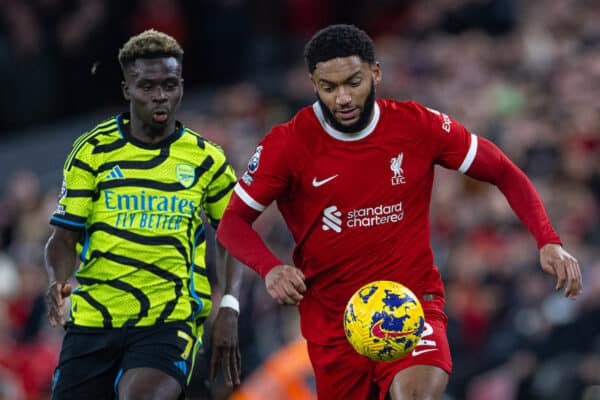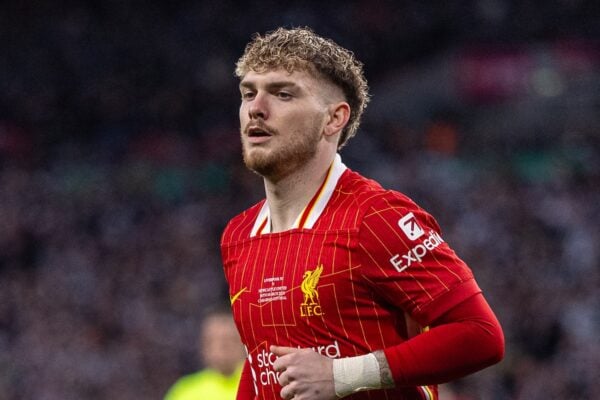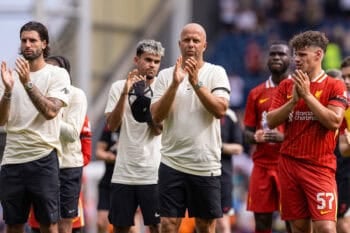Liverpool have seen a new utility man emerge in Jurgen Klopp‘s squad this season, with Joe Gomez potentially solving a problem in the transfer market.
Pro tip for anyone interested in writing for This Is Anfield: try not to write something based on a tweet.
I made an exception for this particular tweet:
Klopp: “Yes we have a lot of players out but don’t worry, I have a plan”
The plan: pic.twitter.com/mS1ILvgGIV
— Raws (@Raws_LFC) January 10, 2024
Joe Gomez has not just been outstanding this season, he’s seemingly been everywhere.
He’s made 27 appearances in all competitions so far this season – since signing in 2015, he’s only bettered that tally three times – and it’s still only January.
The 26-year-old has received a lot of criticism at times in his Liverpool career, having failed to consistently show his best form, particularly after serious injury.
But this campaign, he’s operating at his best level again – and crucially, doing so in multiple positions.
Centre-back

Despite being a centre-back by trade, Gomez has featured there just three times so far this season.
He rose from the bench to play his part in the comeback win over Newcastle after Virgil van Dijk‘s dismissal, excelled in the 3-0 demolition of Aston Villa, and came in for Van Dijk again in the Europa League defeat of Toulouse.
In the latter game, he was remembered more for his assist after switching to a full-back role late on.
Nevertheless, in all three games Liverpool emerged victorious, and Gomez was faultless in all three.
The imperiousness of Van Dijk, the resurgence of Joel Matip and the strong tactical fit for Ibrahima Konate in Liverpool’s system have deprived Gomez of minutes in his preferred position at times this season.
But he has showed, particularly in the game against Villa, that he can still offer plenty as an option there.
Liverpool’s success that day was built on an aggressive high press which needed a high defensive line to sustain it. Gomez’s pace and reading of the game was key to that.
He also made an excellent intervention at 2-0, reading a run to the near post to deny Leon Bailey a goal that would have invited Villa back into the game.
Elbow back

The role of the ‘elbow back’ has become mainstream in recent years.
It refers to the practice of deploying a central defender as a full-back, and tasking them with forming a situational back three.
This allows the opposite full-back to get forwards, creating an asymmetrical structure that opponents find harder to deal with.
It’s also a result of teams seeking greater protection in the last line of defence.
As games get quicker and more physical, the counter-attacking threat of every team has improved, meaning Liverpool must ‘keep the back door locked’ no matter who their opponent is.

This profile of defender was looked at in the summer transfer window, but with no such signing made, Gomez is the clearest fit within the squad.
He was duly deployed there for the visit to Luton, who looked to counter in wide areas and then rain crosses into the box.
Gomez’ height was useful at set-pieces, while he also stepped across to cover well early in the second half when Carlton Morris looked certain to score.
However, the nature of the game – with Liverpool breaking down a low block and Luton countering – led to Gomez venturing forwards to hold width anyway.
Jurgen Klopp therefore replaced him with the more naturally adventurous Kostas Tsimikas, though Liverpool ultimately dropped a frustrating two points.
Full-back

It has been full-back where Gomez has truly shone.
With Trent Alexander-Arnold increasingly stepping into midfield, an overlapping full-back has been something of a plan B at times.
In the vice-captain’s absence, Gomez was asked to invert from right-back in the first half against Wolves, and looked uncomfortable at times.
After the break, Liverpool switched to a more familiar shape, with Gomez and left-back Andy Robertson flying forwards down the wings.
The result was a 3-1 win, and while Robertson took the headlines with a brilliant goal, Gomez also looked excellent in both attack and defence on the right.
Since being an unused substitute at the Etihad in November, Gomez has featured as a right-back or left-back in every Premier League game.
His cameo on the right freed up Alexander-Arnold to seal the comeback win over Fulham, and his introduction at 1-0 down vs. Crystal Palace also contributed to a dramatic 2-1 victory.

But the true value of Gomez has been seen at left-back.
He replaced the injured Tsimikas during the 1-1 draw with Arsenal, with Bukayo Saka failing to complete a single take-on against Gomez in the remaining 55 minutes.
But this was no elbow back performance; Gomez also came closest to a winner with an excellent run and curling effort that whistled past the post.
Gomez has maintained the role in wins over Burnley, Newcastle and Arsenal (again), combining his defensive steel with an added attacking threat that has seen the topic of his long-awaited first senior goal begin to dominate the news cycle.
Liverpool’s Swiss Army knife

Despite topping the league table and having its best defence, Liverpool’s rearguard is a topic of constant debate.
Alexander-Arnold’s migration into midfield has raised calls for a new attacking right-back, although the emergence of Conor Bradley in recent weeks may have an influence on that.
Jarell Quansah has had a meteoric rise this season, but with Joel Matip out of contract this summer, defensive reinforcements are craved among many supporters.
The rise of the elbow back has seen Liverpool linked with a host of versatile left-footed defenders, and the transfer market is open.
And despite stepping up prior to his injury, some have felt an upgrade on Kostas Tsimikas to be necessary in the near future.

Thanks to Joe Gomez, however, Liverpool currently have excellent cover in each of these many roles.
Liverpool’s new Swiss Army knife may not be able to play everywhere all at once.
But his ability to play anywhere in the back line gives Liverpool a range of options for the rest of the season, and for their transfer planning going forwards.

















Fan Comments